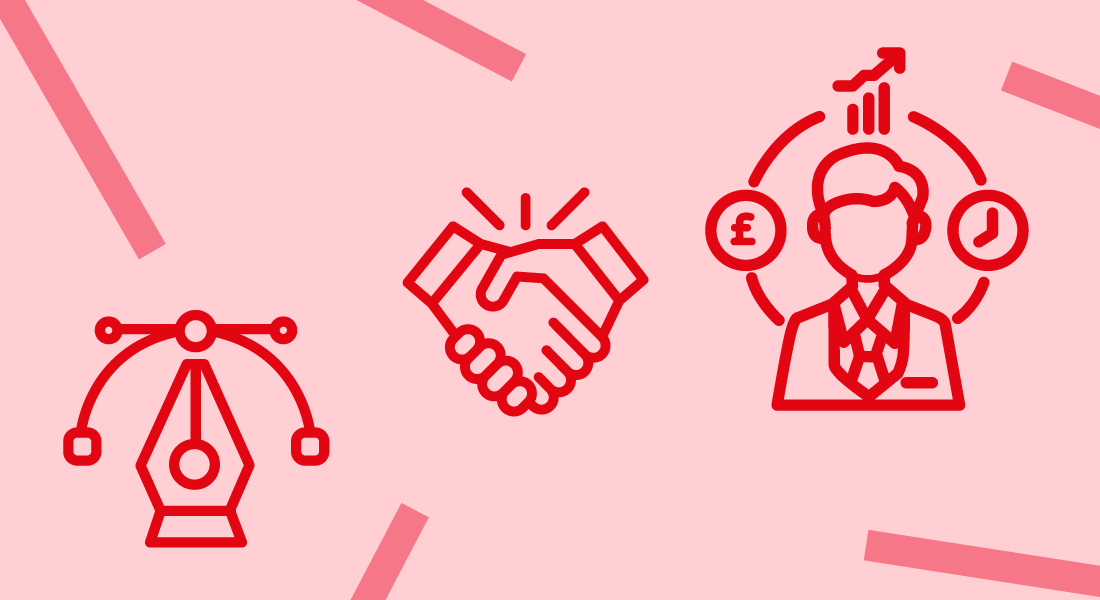Designers and project delivery managers want the same thing – to deliver impact. But it’s all too easy for those on either side to forget what the other brings to the table.
Sometimes, this can even spill over into unhealthy tension.
Over the last few months, BJSS delivery managers and SPARCK designers have been working together to make sure everyone understands their roles and appreciates the contribution of others.
In this post, we’ve taken those conversations and boiled them down into ten key reasons why designers need delivery managers and vice versa.
If you’ve ever thought “What’s the point of a designer on this project?” or “Why do I need a delivery manager making me do all this paperwork?” you might find this helpful.
5 reasons why delivery managers should join design projects
- You want to tackle big human questions
Design tackles the challenges that affect our fundamental needs and human experiences: how we might look after our health, keep the skies safe, support the ecological transition, travel or furnish our homes in the future. Tackling these issues will take time, across multiple projects, and test the skills of even the most experienced delivery managers. - You’re open to using creativity to achieve serious outcomes
To tackle these challenges, we need all the help we can get. It wouldn’t make sense to use only half our brains. We need to engage our ‘right brain’ for analytical tasks and our ‘left brain’ for creative tasks, along with instinctive information processing. Using creativity and design hunches allows us to uncover new insights. The playfulness can feel unfamiliar at first but it’s worth pushing through the discomfort to explore new ways to tackle long-standing challenges. - You want to design for the real world
People are messier than technology and business processes would like to believe. A shiny new solution survives its first encounter with the first real user. Innovation isn’t always a new gadget. It can be about reducing complexity, making handovers more elegant, removing a service, adopting a standard, or transferring innovation from one sector to another. It can be in the back end and totally invisible to the end users. Like little detectives, designers follow clues and keep an open mind to what might solve an issue. - You see the benefit of bringing people to the table
The involvement of users and staff is often the most visible part of a design project, bringing its own challenges. Designers see people as people at the intersection of many identities, and each identity as a scale. They take into consideration that a customer might also be a parent, a commuter, or an employee. Designers help bring them to life in all their complexities and give them a voice. They also work across time: we use past and present experiences to shape future experiences and ensure that the service will work in the future for people, organisations, and the planet. - You want to create services that users can use
Making sure that services deliver value to all the customers they intend to serve can pose real challenges and require delivery managers with a strong understanding of accessible services. The temptation can be to deliver the 80/20 Pareto principle but paying too little attention to edge cases will create a service debt which progressively reduces the value of the new service. Similarly, designing services inclusion-first will help make sure that, by design, vulnerable customers can easily access services and complete the whole customer journey to meet their needs without unnecessary frictions.
- We bring together people and business needs
Human-centered design requires designers to immerse themselves in the experiences of customers and bring their voices to the heart of organisations’ decisions. However, the people lens needs to be balanced with the other parts of the triple bottom line: financial and environmental sustainability. Delivery managers keep a constant eye on the balance. They ensure that the technology, operational, financial and benefit management teams are involved from the start. Furthermore, they can share their knowledge of how the organisation works so that the team can take it into account in the design. - We can manage time
The human-centered design time doesn’t always align with the Agile project management rhythm. User research might flow more naturally over three weeks than two. A slow and steady effort works better to recruit participants with diverse experience; there might be gaps between sprints. It is part of the role of delivery managers to improve the reliability of their team’s estimates, identify the points where they go over budget, work overtime, burn out, or where quality reduces. And that’s particularly necessary in design projects. Consistently, the time it takes to synthesise research is underestimated. The lessons need to be developed across several projects and only become ‘learned’ once they are acted upon, starting with sales teams writing proposals. - We help you move from research to delivery
Human-centered design means diving into the depth and breadth of a challenge. Understanding a problem in its entirety is the strength of researchers and designers who want to know all the users including those with the greatest needs or barriers to access, all the staff, all the time. However, it means they can get lost in a sea of insights. Delivery managers keep the team focused on the objective and help them assess when there is sufficient evidence to make an informed business decision. - We support implementation and transformation
Human-centered design is strong early in the process of innovation: what shall we do, why and how? The further we go into implementation; the fewer designers are in their element. They need delivery managers to think ahead of the constraints of implementation so that they can be considered early in the design phase.
More widely, the role of delivery managers is critical to support the organisation’s transformation. Human-centered design projects address tough challenges, challenge the status quo and involve those who don’t normally have a seat at the table, so the risk of ‘crisis’ is high. Delivery managers are the guardians to prevent avoidable issues and support the good kind of trouble. - And importantly, we look after the people
Design teams are highly motivated to deliver impact at scale for users, especially when they work closely with them. However, they can be so keen to deliver that they do so at the expense of their own well-being. They will often focus on what’s left to be done, and what isn’t as good as it could be. The delivery manager helps protect them from their own worst instincts, celebrate successes, and support well-being to make sure that we don’t design future experiences at the cost of present ones. This pastoral care is a fundamental difference between a project manager and a delivery manager.
How are you managing relationships between designers and delivery managers? Are you intrigued by researchers, designers and delivery managers coming together to tackle real-life challenges? This conversation is a work in progress. We would love to hear your experience, get in touch.



